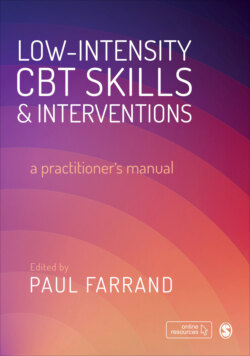Читать книгу Low-intensity CBT Skills and Interventions - Группа авторов - Страница 37
На сайте Литреса книга снята с продажи.
Therapeutic Drift during Support Sessions
ОглавлениеAlthough clear distinctions should be drawn between low- and high-intensity CBT, challenges can be encountered when an LICBT psychological therapy practitioner drifts between supporting single-strand CBT self-help interventions and delivering multi-strand interventions (Waller, 2009). When the practitioner drifts into HICBT, adopting techniques such as downward arrow (Beck, 1995) or continuum methods (Padesky, 1994), challenges to working outside of competencies developed during training (Roth and Pilling, 2007a) or working within constraints imposed by the therapeutic dose is encountered. They may be more likely to arise when the LICBT psychological therapy practitioner drifts into employing HICBT techniques to deliver specific stand-alone worksheets within sessions rather than supporting the patient to work through CBT self-help workbooks between sessions. However, LICBT psychological therapy practitioners losing confidence in the LICBT interventions when patients show little sign of recovery has also been recognised as a factor that can lead to therapeutic drift (Telford and Wilson, 2010).
